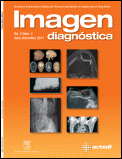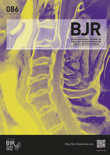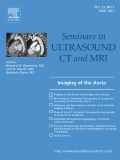
Imagen Diagnostica
Scope & Guideline
Revealing Knowledge in Diagnostic Imaging
Introduction
Aims and Scopes
- Diagnostic Imaging Techniques:
The journal emphasizes the investigation and development of various diagnostic imaging modalities including MRI, CT, ultrasound, and X-ray, aiming to enhance diagnostic accuracy and patient care. - Integration of Artificial Intelligence:
There is a clear focus on the intersection of artificial intelligence and radiology, exploring how AI can improve imaging processes, diagnostics, and workflow efficiency. - Clinical Case Reports:
The publication frequently includes clinical case studies that highlight unique or rare conditions, providing practical insights for practitioners in the field. - Quality Control and Standards:
A significant aspect of the journal's scope is the emphasis on quality control measures in imaging practices, ensuring adherence to safety and efficacy standards. - Educational Development in Radiology:
The journal also covers themes related to the training and professional development of imaging technicians and radiologists, reflecting the importance of education in improving imaging outcomes.
Trending and Emerging
- Artificial Intelligence Applications:
The integration of artificial intelligence in diagnostic imaging is gaining traction, with increasing publications exploring its role in enhancing diagnostic accuracy and operational efficiency. - Advanced Imaging Techniques:
There is a notable rise in the exploration of advanced imaging techniques, such as kymography and fetal MRI, which are paving the way for improved diagnostic capabilities in complex cases. - Multidisciplinary Approaches:
Emerging themes include collaborative studies that involve multiple disciplines, reflecting a trend towards holistic patient care and the importance of teamwork in diagnosis and treatment. - Focus on Quality Control:
An increasing emphasis on quality control and standardization in imaging practices is evident, demonstrating a commitment to ensuring safety and efficacy in diagnostic procedures. - Educational Innovations in Radiology:
There is a growing trend towards discussing educational advancements and training methodologies within the field, highlighting the importance of continuous professional development for imaging practitioners.
Declining or Waning
- Traditional Imaging Techniques:
There has been a noticeable decrease in the publication of papers solely focused on traditional imaging techniques without innovative applications or comparative studies, indicating a shift towards more advanced methodologies. - General Public Health Discussions:
Papers that broadly address public health issues without a direct link to imaging practices have become less frequent, suggesting a narrowing of focus towards more specific imaging-related topics. - Basic Case Studies with Limited Novelty:
There appears to be a reduction in the submission of basic case studies that do not introduce new findings or techniques, possibly due to the journal's emphasis on novel contributions to the field.
Similar Journals

Radiology-Imaging Cancer
Enhancing Cancer Treatment through Radiological Innovations.Radiology-Imaging Cancer is a prestigious journal published by the Radiological Society of North America (RSNA), focusing on the critical intersection of radiology, oncology, and advanced imaging techniques. This journal stands out in its field with a commendable ranking in the Q2 category for Medicine (miscellaneous) and Oncology, and an impressive Q1 ranking in Radiology, Nuclear Medicine and Imaging, according to the 2023 quartiles. With an ISSN of 2638-616X, it serves as an essential platform for the dissemination of research that contributes to the understanding and improvement of cancer diagnosis and treatment. Its comprehensive scope encompasses a range of topics, from innovative imaging modalities to clinical applications in oncology, making it a valuable resource for researchers, clinicians, and students interested in the evolving field of cancer imaging. Despite being published in the United States, the journal aims for a global reach, catering to a wide audience dedicated to advancing medical science.

Applied Radiology
Empowering Radiologists Through Cutting-Edge ResearchApplied Radiology, an esteemed journal published by Anderson Publishing, Inc., has been a significant contributor to the field of radiology since its inception in 1973. With a focus on innovative imaging techniques and their application in clinical practice, this journal serves as an invaluable resource for researchers, healthcare professionals, and students aiming to stay at the forefront of advancements in radiology, nuclear medicine, and imaging. Applied Radiology holds a Q4 quartile ranking in the category of our field, indicating its niche yet essential role in disseminating knowledge and fostering dialogue among radiologists. The journal operates primarily under subscription access, ensuring a curated access to publications that reflect the dynamic nature of research and technology in radiology, particularly up to the year 2024. As it continues to guide the future of radiological practices, Applied Radiology remains dedicated to delivering high-quality, peer-reviewed content that supports ongoing education and clinical excellence.

BRITISH JOURNAL OF RADIOLOGY
Shaping the Future of Imaging through Rigorous ResearchBritish Journal of Radiology is a leading peer-reviewed journal published by the British Institute of Radiology, dedicated to advancing the field of radiology, nuclear medicine, and imaging. With a prestigious history dating back to 1945, this journal is at the forefront of disseminating cutting-edge research and innovations that significantly impact clinical practice. Currently enjoying a Q1 ranking in the field of radiology and Q2 in general medicine for 2023, it is recognized for its rigorous standards and high-quality content, ranking #87 out of 333 in Scopus for specialties related to Medicine, Radiology, Nuclear Medicine, and Imaging, placing it in the 74th percentile. Researchers, professionals, and students are encouraged to engage with the latest findings and comprehensive reviews presented within its pages, which contribute not only to academic discourse but also to the evolution of practice in the wider medical community.

EUROPEAN JOURNAL OF RADIOLOGY
Bridging Research and Clinical Excellence in RadiologyThe European Journal of Radiology, published by Elsevier Ireland Ltd, is a premier peer-reviewed journal in the fields of radiology, nuclear medicine, and imaging. Established in 1981, it has carved a significant niche within the academic community, showcasing innovative research that enhances medical imaging practices and improves patient care. With an impressive ranking in the Q1 category for both Medicine (miscellaneous) and Radiology, Nuclear Medicine, and Imaging in 2023, the journal is recognized globally for its commitment to advancing scientific knowledge and improving imaging methodologies. The journal's Scopus ranking of #60/333, placing it in the 82nd percentile, underlines its reputation for high-quality research and scholarly contributions. While traditionally a subscription-based journal, it continually evolves to meet the demands of the academic landscape, aiming to bridge the gap between research and clinical practice. Researchers, healthcare professionals, and students alike can benefit from exploring its extensive archives and current publications, which are curated to foster education and innovation in the medical imaging domain.

SEMINARS IN ULTRASOUND CT AND MRI
Connecting Clinicians with Cutting-edge Imaging ResearchSEMINARS IN ULTRASOUND CT AND MRI is a prestigious academic journal dedicated to advancing the fields of radiology, nuclear medicine, and imaging. Published by W B SAUNDERS CO-ELSEVIER INC, this journal has been a cornerstone of scholarly communication since 1984, providing a platform for high-quality research and review articles that enhance the understanding of diagnostic imaging techniques. With a current impact factor reflected in its Q3 quartile ranking among 333 journals in its category, it remains a valuable resource for researchers and clinicians alike. The journal's focus includes but is not limited to innovations in ultrasound, computed tomography, and magnetic resonance imaging, making it essential for professionals looking to stay at the forefront of imaging science. While it operates under a subscription model, its extensive archive of influential articles ensures ongoing access to critical knowledge and developments in the field. With a commitment to quality and relevance, SEMINARS IN ULTRASOUND CT AND MRI continues to contribute significantly to the evolving landscape of medical imaging.

Japanese Journal of Radiology
Empowering Knowledge in Radiology Through Open AccessThe Japanese Journal of Radiology, published by SPRINGER, serves as a premier platform for disseminating cutting-edge research and clinical advancements in the fields of radiology, nuclear medicine, and imaging. With an ISSN of 1867-1071 and E-ISSN 1867-108X, this journal has established itself as a vital resource for practitioners, researchers, and students alike. Renowned for its high-quality peer-reviewed articles, it currently enjoys a respectable impact factor within the Q2 category of Scopus rankings, placing it in the 69th percentile among 333 journals in its field. The journal has seen consistent convergence of research from 2009 to 2024, further underscoring its commitment to advancing the understanding of radiological practices. Importantly, the journal offers Open Access options to facilitate widespread dissemination of knowledge, ensuring that vital research reaches its audience without barriers. Addressed in Japan, the Japanese Journal of Radiology plays a critical role in enhancing the global discourse on medical imaging, making it an essential resource for anyone engaged in this dynamic field.

JOURNAL OF DIGITAL IMAGING
Innovating Radiology Through Cutting-Edge ResearchJOURNAL OF DIGITAL IMAGING, published by Springer, is a premier journal dedicated to the field of digital imaging, encompassing significant developments in the intersecting disciplines of radiology, computer science applications, and ultrasound technology. With its impressive Q1 ranking in the categories of Radiology, Nuclear Medicine and Imaging, and Radiological and Ultrasound Technology, and a substantial Q2 ranking in Computer Science Applications, this journal is positioned at the forefront of research dissemination in these vital areas. The ISSN 0897-1889 and E-ISSN 1618-727X signify its broad reach and accessibility, while its Scopus rankings demonstrate its robust impact in the academic community, ranked #41/333 in Radiology and earning a notable 87th percentile status. Since its inception in 1988, the journal has served as a vital resource for researchers and professionals seeking to advance their understanding of digital imaging technologies and their applications. Although it does not currently offer open access options, it continues to foster scholarly dialogue and innovation, making it an indispensable platform for those committed to excellence in imaging science and technology.

Emergency Radiology
Empowering Healthcare Professionals with Essential Radiology KnowledgeEmergency Radiology, published by SPRINGER HEIDELBERG, is a leading journal in the fields of emergency medicine and radiology, dedicated to advancing the understanding and application of diagnostic imaging in urgent medical conditions. Established in 1994, this journal has consistently contributed to the discourse around emergency diagnostics, maintaining a strong position within the academic community, as evidenced by its Q2 rankings in both Emergency Medicine and Radiology, Nuclear Medicine and Imaging categories as of 2023. With a distinguished focus on innovative research and case studies, it serves a diverse audience of researchers, clinicians, and healthcare professionals who seek to enhance their knowledge and improve patient outcomes in emergency settings. While the journal is not currently open access, it offers robust subscription options and continues to be an integral resource for those at the forefront of emergency care. With an ISSN of 1070-3004 and an E-ISSN of 1438-1435, Emergency Radiology is positioned to remain a key player in shaping the future of medical imaging through its commitment to high-quality research and evidence-based practices.

Egyptian Journal of Radiology and Nuclear Medicine
Pioneering Research for a Healthier TomorrowThe Egyptian Journal of Radiology and Nuclear Medicine, published by Springer, is a premier open access journal that has provided valuable insights and advancements in the fields of radiology and nuclear medicine since its initiation in 2010. With an E-ISSN of 2090-4762, this journal is dedicated to bridging the gap between research and clinical practice, allowing for the dissemination of high-quality research to a global audience. Situated in Germany, it enjoys a robust reputation in the academic community, evidenced by its categorization in the Q3 quartile for 2023, as well as its Scopus ranking, where it holds a position of #225 out of 333 in the domain of Radiology, Nuclear Medicine and Imaging, placing it in the 32nd percentile. The journal's open access model ensures that researchers, professionals, and students can freely access innovative studies, reviews, and case reports that discuss the latest methodologies, technological advancements, and clinical outcomes in radiology and nuclear medicine. As it looks toward its converged years spanning from 2010 to 2024, the Egyptian Journal of Radiology and Nuclear Medicine continues to be an essential resource for advancing knowledge and fostering ongoing collaboration in these critical fields.

SA Journal of Radiology
Transforming Practice: Elevating Radiology Through Open AccessThe SA Journal of Radiology is a prominent open-access journal published by AOSIS, dedicated to advancing knowledge in the fields of Radiology and Ultrasound Technology. Established in 2004, this South African journal provides a platform for researchers, professionals, and students to disseminate valuable findings and share innovative practices in medical imaging. With an ISSN of 1027-202X and an E-ISSN of 2078-6778, the journal has become an important resource for those involved in radiological sciences, despite currently holding a Q4 ranking in both Radiological and Ultrasound Technology and Radiology, Nuclear Medicine and Imaging categories. Covering a converged time span from 2014 to 2024, the journal aims to promote scholarly communication and enhance the accessibility of research, positioning itself as a key player in the global radiological community. In a landscape where open access is increasingly critical, the SA Journal of Radiology is committed to fostering research collaboration and facilitating the exchange of ideas among clinicians and academics alike.